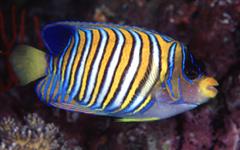Angelfish - Regal
Regal Angel Scientific Name: Pygoplites diacanthus
Sat, 14th June, 2025 - 7:37 pm GMT
Sponsor Ads:

Alternative Name
Regal Angel Scientific Name: Pygoplites diacanthusBasic Info
The Regal Angel has a yellow face and chest when collected from the Red Sea. Juveniles are marked with a prominent eye-spot on the dorsal fin and several cross bars outlined in a dark shade. They are sometimes mistaken for Angels of the genus Centropyge. At maturity, most Regal Angels reach lengths of ten inches (25 centimeters). Their basic yellow-orange coloration is offset by a number of vertical bars. These bars are bluish-white in color, and are defined by clean black outlines. The anal fin shows similar blue bars, which follow the curves of this fin, often at geometric angels. These bars lack the thick black outline that the body bars have. The Regal Angel's fan shaped tail is a bright yellow color, often a brighter shade than that of the rest of the body. It is separated from the body by short blue, black-outlined bars. The ventral fin of a Regal Angel is the same yellow color as the tail. Often, the dorsal fin reaches a blunt point, and is very filled in with a dark shade. However, the bars may show variable patterns on different Regal Angels.
Health
Regal Angels should be kept in temperatures between 72 and 78 degrees Fahrenheit (23 to 26 degrees Celsius). The pH level should remain at 8.3 or 8.4, with a specific gravity between 1.020 and 1.025. The part of this range below 1.023 is preferred in a fish-only enclosure, though the upper range, above 1.023, would be preferred in aquariums containing invertebrates, in order to keep these animals healthy. Regal Angels should be allowed plenty of unobstructed swimming space in addition to a number of good hiding places. They normally do not tolerate other Regal Angels or other similar fish. Regal Angels may pick at tridacnid clams, long-tentacled anemones, and coral polyps. A Regal Angel should be fed an extremely varied diet to ensure it receives proper nutrition. These fish seem to do well in reef environments, where they can graze on algal growth. Often, sponges are used to start juveniles feeding. Mysid shrimp and minced krill are also often accepted. Although younger Regal Angels seem to adapt better to captive environments, they are not offered as commonly as mature adults are. Often it seems adult Regal Angels are not able to adapt to captive diets.Habitat
Saltwater fishBehavior
Despite its beautiful appearance, the Regal Angel is not often kept successfully in captivity. For those experienced enough and lucky enough to maintain a Regal Angel, the achievement can be extremely rewarding. Regal Angels seem to do best when kept in reef aquariums, where they can feed on organisms or algae growing on various items like live rock. A Regal Angel is normally kept as the only Angel in a tank, though sometimes small or dwarf Angels may also live in the enclosure. These Angels are notoriously difficult to keep. Adults seem to be unable to adapt to captive diets, while juveniles are not often sold in the pet trade. It is believed that this could be due to their habit of living in deeper areas than do adults. In the wild, juvenile Regal Angels feed on sponges. Mature adults seem to prefer coral-rich reefs, and are commonly found at depths between 3 and 66 feet (1 to 20 meters). Often, areas with currents or plenty of wave activity are preferred. Regal Angels are normally found alone, though on rare occasions, pairs are seen. In a reef aquarium, Regal Angels have been known to pick at clams, mussels, long-tentacled anemones, and various coral polyps. For this reason, they should be observed to ensure that they are not harassing or killing any invertebrates in the aquarium. THey are not considered reef safe. Most Regal Angels spend a good deal of time hiding, so plenty of places large enough to accommodate them should be offered to lower their stress levels. These fish usually swim with their undersides parallel to the ground, even when swimming up or down in the enclosure. They have also been observed swimming on their backs.Origin
Indo-PacificHistory
Regal Angels are native to the eastern Pacific Ocean, Indian Ocean, and the Red Sea. Red Sea and Indian Ocean specimens are preferred to Regal Angels collected in the Pacific, since these fish may be drugged for capture. The "orange throat" Regal Angel refers to the variety found in the Indian Ocean and is used to differentiate them from those caught in the Pacific which will not have this orangish area. The "orange throat" and Red Sea varieties are much more likely to feed in captivity.Common Foods
N/ASponsor Ads:
May you live in interesting times. -- Unknown
Angelfish - Regal
Coded by: BGID® | ALL RIGHTS RESERVED Copyright © 2000-2025
Disclaimer | Privacy | Report Errors / Contact | Credits
















